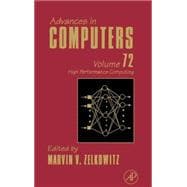
What is included with this book?
| Contributors | p. ix |
| Preface | p. xvii |
| DARPA's HPCS Program: History, Models, Tools, Languages | |
| Historical Background | p. 3 |
| Productivity Systems Modeling | p. 19 |
| Productivity Evaluation on Emerging Architectures | p. 37 |
| The DARPA HPCS Language Project | p. 58 |
| Research on Defining and Measuring Productivity | p. 69 |
| The HPC Challenge Benchmark Suite | p. 86 |
| Summary: The DARPA HPCS Program | p. 95 |
| References | p. 96 |
| Productivity in High-Performance Computing | |
| Introduction | p. 102 |
| A General Formulation | p. 105 |
| Factors Determining HPC Productivity | p. 107 |
| A Special Theory of Productivity | p. 121 |
| A User-based Model of Productivity | p. 124 |
| Software Development & Productivity | p. 129 |
| Related Works | p. 131 |
| Conclusions | p. 133 |
| References | p. 134 |
| Performance Prediction and Ranking of Supercomputers | |
| Introduction | p. 137 |
| Methods for Predicting Performance | p. 139 |
| A Method for Weighting Benchmarks | p. 143 |
| Examples | p. 148 |
| Using End-to-End Runtimes | p. 152 |
| Using Basic Trace Data | p. 160 |
| Application-Independent Rankings | p. 163 |
| Conclusion | p. 168 |
| Acknowledgments | p. 169 |
| References | p. 170 |
| Sampled Processor Simulation: A Survey | |
| Introduction | p. 174 |
| Trace-Driven versus Execution-Driven Simulation | p. 176 |
| Sampled Simulation | p. 178 |
| Simulation Speed | p. 180 |
| Representative Sampling Units | p. 182 |
| Architecture State | p. 190 |
| Microarchitecture State | p. 195 |
| Case Studies | p. 214 |
| Summary | p. 217 |
| Acknowledgments | p. 217 |
| References | p. 217 |
| Distributed Sparse Matrices for Very High Level Languages | |
| Introduction | p. 226 |
| Sparse Matrices: A User's View | p. 227 |
| Data Structures and Storage | p. 228 |
| Operations on Distributed Sparse Matrices | p. 230 |
| SSCA #2 Graph Analysis Benchmark | p. 239 |
| Looking Forward: A Next-Generation Parallel Sparse Library | p. 248 |
| Conclusion | p. 250 |
| References | p. 251 |
| Bibliographic Snapshots of High-Performance/High-Productivity Computing | |
| Introduction | p. 255 |
| Computational Environments in Government, Academia and Industry | p. 257 |
| References | p. 259 |
| Computational Science Education (CSE) | p. 260 |
| References | p. 263 |
| Supercomputing Architecture | p. 264 |
| References | p. 265 |
| Some HPC Issues | p. 271 |
| References | p. 272 |
| Benchmarking Issues and Concerns | p. 275 |
| References | p. 281 |
| Acceleration Techniques for HPC Applications | p. 286 |
| References | p. 287 |
| The Race for Petaflop Computing | p. 292 |
| References | p. 300 |
| Influences of Floating-Point Arithmetic on Computational Results | p. 303 |
| References | p. 304 |
| Industrial HPC Progress | p. 305 |
| References | p. 311 |
| Access to On-Demand HPC | p. 314 |
| References | p. 315 |
| A Few HPC Videos | p. 315 |
| References | p. 316 |
| Author Index | p. 319 |
| Subject Index | p. 329 |
| Contents of Volumes in This Series | p. 339 |
| Table of Contents provided by Ingram. All Rights Reserved. |
The New copy of this book will include any supplemental materials advertised. Please check the title of the book to determine if it should include any access cards, study guides, lab manuals, CDs, etc.
The Used, Rental and eBook copies of this book are not guaranteed to include any supplemental materials. Typically, only the book itself is included. This is true even if the title states it includes any access cards, study guides, lab manuals, CDs, etc.